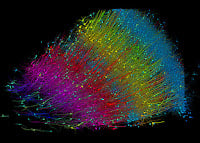Researchers Reconstruct 3D Fragment of Human Brain

By combining high-powered microscopy with AI-guided illustration software, researchers reconstructed a 1 cubic millimeter fragment of living human brain tissue; these findings were published in today’s issue of Science.
“We reconstructed thousands of neurons, more than a hundred million synaptic connections, and all of the other tissue elements that comprise human brain matter, including glial cells, the blood vasculature, and myelin,” wrote Alexander Shapson-Coe, M.B. B.Chir., Ph.D., of Harvard University and colleagues.
This detailed 3D rendering required 1,400 terabytes of data. By comparison, today’s high-end computer games typically contain around 0.1-0.2 terabytes of data.
The researchers obtained their brain tissue sample during a surgical procedure on a patient with epilepsy. To gain access to the pathological site, surgeons removed a tiny portion of the patient’s frontal cortex, which the researchers quickly preserved and then imaged with an electron microscope. The removed fragment was around 4 mm long and just 0.17 mm thick, and since the sample was vertically oriented it contained multiple layers of frontal cortex tissue.
Next, the researchers used AI algorithms developed by Google to identify and color-code all the different cell types present in the sample, providing a vivid reconstruction of the cellular composition of this fragment of brain tissue, as well as the extensive electrical wiring.
The reconstructed sample included about 16,000 neurons, 32,000 neuronal support cells called glia, and 8,000 blood-vessel related cells. Combined, these 16,000 neurons formed over 150 million synaptic connections amongst each other. In nearly 97% of instances a pair of neurons would form a one-to-one connection; however, the researchers identified exceedingly rare cases where two neurons were connected by 50 or more synapses.
“Without question, approaches to uncovering the meaning of neural circuit connectivity data are in their infancy, but this… dataset is a start,” Shapson-Coe and colleagues wrote.
“Because the dataset is large and incompletely scrutinized, we are sharing all of the data in an online resource and also providing tools for analysis and proofreading,” they added.
For related information, see the Psychiatric News article, “Are Brain Organoids the Next Big Thing?”
(Image: GOOGLE RESEARCH AND LICHTMAN LAB)
Don't miss out! To learn about newly posted articles in Psychiatric News, please sign up here.





